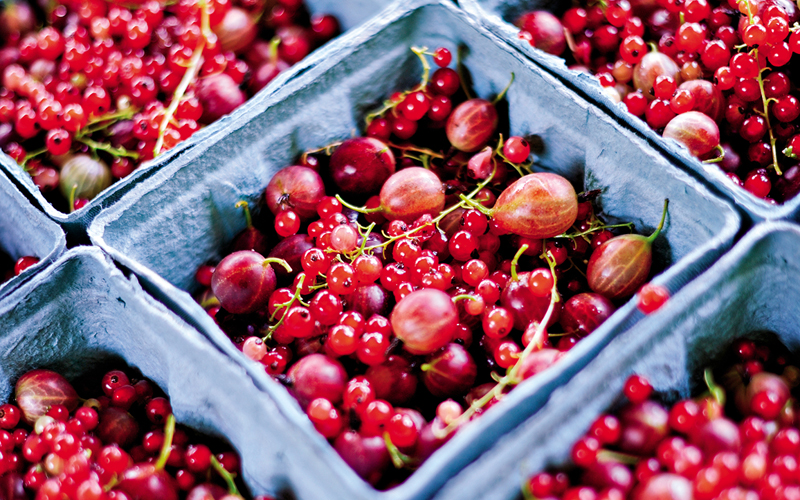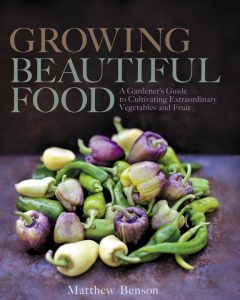
photo and text by guest blogger Matthew Benson, photographer, organic farmer, and author of Growing Beautiful Food
“Out of such chaos comes the dancing star,” once said my favorite dystopian curmudgeon, Nietzsche, who may have come from farming blood, for all I know.
Nietzsche’s obsessions with hardship and trial as paths to enlightenment, just like Homeric and Eastern mythology’s, are very much in the spirit of agriculture. And if agriculture has a grail—an odyssey of tribulation and effort—it’s organic fruit.
Fruit is the most difficult thing we grow. When cultivating organic fruit, from pome (apple, pear, quince) and stone (plum, cherry) to thorny brambles, it’s us against insects, fungi, birds, squirrels, chipmunks, and the rest of ravenous creation. Even our chickens went on a bender this week when a few cherries dropped to the orchard floor while we were harvesting.
Fruit is desire; it’s forbidden biblical temptation. (We might still be living in sinless oblivion had Eve handed Adam a fistful of kale.) And while most fruit is sweet, tempting our evolutionary lust for sugar, I’m personally in love with sour: the sharp, lip-puckering sour of ripe currants or gooseberries or the tang of tart cherries, bloodred and swollen, with stone-hard pits that must be spat. They just seem edgier and a less obvious choice, given the physiology of taste.
Sweet has been something we’ve done way too well for too long—and we are paying the price in an epidemic of obesity and diabetes. We’ve been sugar-bombed and beaten into a neophobic lull by agribusiness for decades. It’s time for sour to have its moment. One look at the growing popularity of the sour and bitter taste spectrum, from kombucha and hoppy beer to pickling just about everything, and it seems sour is making strides.
So what is it about tartness? Is it just that it’s an antivenin to the corn-sweetened everything of our culture? “Sour foods are growing because of what they aren’t: sweet,” says Mark Garrison in Slate. “With public health officials in open warfare with soda and corn syrup, the opposite of their flavor profile sounds an awful lot safer to many consumers.”
Stonegate, my organic farm, has been going sour since its inception, with black and red currants, sour cherries, gooseberries, and chokeberries (as in “choking on insane bitterness”). Cultivating fruit is what drew me to farming in the first place, plus an affinity for the work of 19th-century cultural stylist Andrew Jackson Downing and his ideas on both fruit cultivation and rural architecture. An orchard heavy with organic fruit seemed as close to the vault of agricultural nirvana as I could get.
I think Downing would have liked it here, even the way I first found it. The wonderful Gothicness of the place—clambered over by bindweed, wild grape, and lilac, with the lovely bones barely poking through a skin of neglect: Stonegate in the raw, abandoned to time and indifference.
Downing would have seen the potential, particularly now, with the orchard in its fullness, radiant and heavy with the sweet and sour glimmer of desirable fruit, like Nietzsche’s dancing stars, lighting up the farm.

Matthew Benson is one of America’s most prominent food and garden photographers, as well as a writer and organic farmer. His work is widely published and he writes, photographs, and lectures frequently on issues of sustainability and organics. His work has been featured in numerous publications, including Better Homes & Gardens, Condé Nast Traveler, Traditional Home, Esquire, The New York Times, Organic Gardening, Country Living, and Saveur. He lives on an 1850s Carpenter Gothic estate farm in New York’s Hudson River Valley. Visit him at matthewbenson.com, stonegatefarmNY.org, and growingbeautifulfood.com.

Adapted from Growing Beautiful Food: A Gardener’s Guide to Cultivating Extraordinary Vegetables and Fruit (copyright 2015) by Matthew Benson. By permission of Rodale Books. Available wherever books are sold.




No comments yet.